If you’ve ever wondered what it was like for a teenager to grow up to be like Tyrannosaurus – always hungry and in a bad mood – you might know that he could be more accurate than that. The carnivorous king had different growth patterns from other carnivorous dinosaurs, characterized by an exceptional growth period, during which time they were probably more hungry and irritated than before. Meanwhile, even the equivalent-sized throbs were more like the imaginary tortoises of the Aesop’s than the rabbits, reaching their enormous size through slow and steady growth.
Like the rings on the trunk of a tree, our bones maintain a record of their development in the growth layers. After observing that T. Rex and his close relatives grew remarkably in size during adolescence, Dr. Tom Cullen of the Field Museum went out to see if this same lifestyle was a common feature among dinosaurs.
“We wanted to look at a wide range of different-throated, two-legged, carnivorous dinosaurs to understand the broader patterns of growth and evolution in the group,” Cullen said in a statement. “We especially wanted to understand how many of them got so big – how did T. rex come up with the only way to do it?”
Most of these dinosaurs have bone rings that indicate lifelong steady growth, including allosauroids, companion theropods, some of which survived their 40s. Rex reached size. Tyrannosaurus was an exception. Cullen saw that the SU was growing at the age of 20, but survived at about 33. She had to be involved in packing 15-20 kilos a week as a teenager so early.
Birds are surviving theropods, and they all grow at a young age. However, there are more similarities between the crocodiles and alligators of Tyrannosaurus and many other former Theropods that reach a certain size and prolong their entire life rather than stop.
The question the team wanted to answer was more complicated than simply measuring the rates of different dinosaur species. As the body parts of some people grow larger than others and go to an awkward stage before the rest of the body is caught, dinosaurs can do the same thing.
Dr. Cullen took a core from SUV’s left thigh bone. However, the authors found that weightless dinosaur bones were regenerated over a lifetime, and preserving the growth rings does a bad job of presumably t. Rex’s arms grew earlier than the rest of their body and it was long enough to be useful for teenagers.
Although the study focused on thromboses, Cullen noted that t. Some of the vegetarian dinosaurs promoted by Rex also had a rapid increase in juvenile development. Although, on the other hand, prey on sauropods which take much longer to reach full size.
“We can’t say for sure, but there could be some sort of selection pressure for the coelurosaurs to continue to grow with their prey, or for the allosauroids to grow in size as their prey size was also increasing,” Cullen said. However, he acknowledged that this is not the case in the United States.













